The guide dog harness is more than just equipment; it’s a vital communication tool between a handler and their dog, enabling safe navigation and independence. It allows handlers to feel subtle movements, enhancing teamwork and trust, while the dog remains focused on guiding when wearing the harness.
1.1 What is a Guide Dog Harness?
A guide dog harness is a specially designed piece of equipment that connects a visually impaired handler to their service dog, enabling safe and independent navigation. It consists of a sturdy vest or saddle worn by the dog, equipped with a handle for the handler to hold. The harness is lightweight and made from durable materials like latigo leather, ensuring comfort and longevity. It features adjustable straps and a secure attachment point to ensure a proper fit. The harness is not just a physical tool but also a communication bridge, allowing the handler to sense the dog’s movements and guidance. When a dog is harnessed, it signifies that it is working and should not be distracted. The design includes reflective edges for visibility and may come in specific colors, such as white for qualified guide dogs and brown for those in training. The harness is essential for maintaining control and trust between the handler and the dog, fostering a partnership that enhances daily life.
1.2 The Importance of a Guide Dog Harness in Daily Life
A guide dog harness is indispensable for visually impaired individuals, enabling safe and independent navigation through daily life. It serves as a critical tool for mobility, allowing handlers to move confidently through various environments, from bustling streets to quiet parks. The harness facilitates clear communication between the handler and the dog, ensuring synchronized movements and obstacle avoidance. Its lightweight yet durable design provides comfort for extended use, while reflective elements enhance visibility in low-light conditions. Beyond practicality, the harness fosters a sense of independence and empowerment, allowing users to engage fully in their communities. It also symbolizes trust and responsibility, as both handler and dog rely on each other for seamless teamwork. When a guide dog is in harness, it is fully focused on its role, prioritizing the handler’s safety above all else. This partnership exemplifies how a simple yet well-designed tool can profoundly impact quality of life, offering freedom and confidence to those who need it most.
Types and Designs of Guide Dog Harnesses

Guide dog harnesses vary in design and purpose, with options like the UniFly for enhanced communication and T-touch for puppies. Colors indicate roles: white for blindness, brown for training, and reflective edges for visibility, ensuring functionality and safety.
2.1 Colors and Their Meanings
The colors of guide dog harnesses carry specific meanings, helping to identify a dog’s role and status. A white harness is commonly used for qualified guide dogs, signaling that the dog is working and assisting a handler with visual impairments. This iconic color is widely recognized and indicates professionalism. A brown harness is typically reserved for dogs in training, alerting others that the dog is still learning and may require extra patience or space. Additionally, some organizations use a red and white harness to denote active working status. Reflective edges on harnesses enhance visibility, ensuring safety in low-light environments. Understanding these color codes is essential for public awareness, as they communicate the dog’s working status and the need for respect. It’s important not to interact with a dog in harness, as this could distract them from their duties. The color system plays a vital role in maintaining the effectiveness of guide dog teams in public spaces.
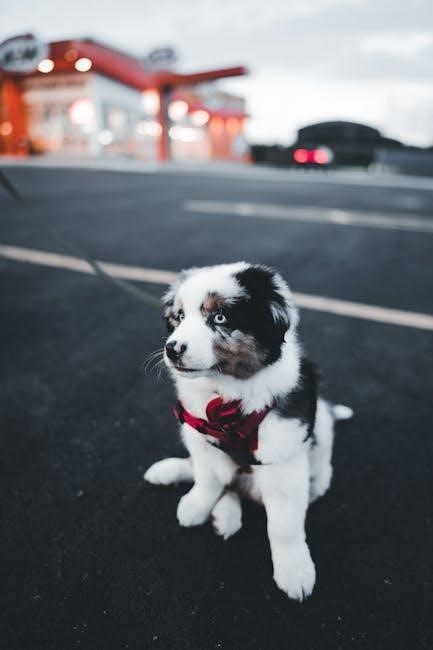
2.2 Specialized Harnesses for Different Needs
Guide dog harnesses are tailored to meet specific requirements, ensuring optimal functionality for both the handler and the dog. The UniFly Harness stands out as a lightweight option designed for enhanced communication, allowing handlers to feel subtle movements through the handle. For mobility assistance, the DT Guide Harness is popular, featuring sturdy leather and reflective strips for increased visibility. T-touch harnesses are specifically designed for puppies in early training, promoting comfort and ease of use. Some harnesses include adjustable straps and quick-release buckles for convenience, while others prioritize durability with reinforced materials. Specialized designs may also incorporate features like padded chest plates or ergonomic handles to enhance comfort during long walks. Reflective edges and vibrant colors further improve safety in low-light conditions. These tailored designs ensure that each guide dog team can find a harness that meets their unique needs, whether for daily navigation, training, or specialized assistance roles.
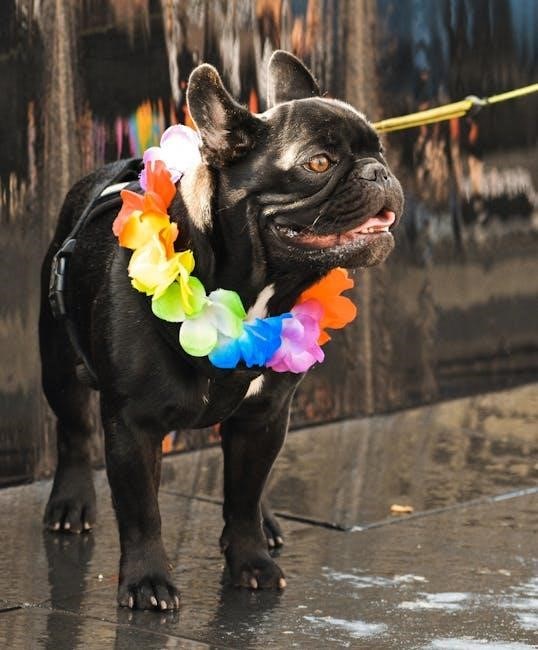
How to Properly Put On a Guide Dog Harness
Start with a step-in style: guide your dog’s legs through the openings, ensuring the D-ring is centered on their back. Adjust straps for a snug fit, then secure the buckles firmly.
3.1 Step-by-Step Guide to Harnessing Your Dog
Start by introducing the harness to your dog in a calm environment. Gently place the step-in style harness on the ground and guide your dog’s front paws through the leg openings. Ensure the D-ring is centered on your dog’s back for proper alignment.
Next, lift the harness and slide it over your dog’s head, making sure the chest strap rests comfortably behind the front legs. Adjust the straps to ensure a snug fit, avoiding any tightness that could cause discomfort.
Secure the buckles firmly, starting with the girth strap, and double-check all adjustments for a balanced fit. Finally, attach the leash to the D-ring and give your dog a treat or praise to reinforce positive association with the harness.
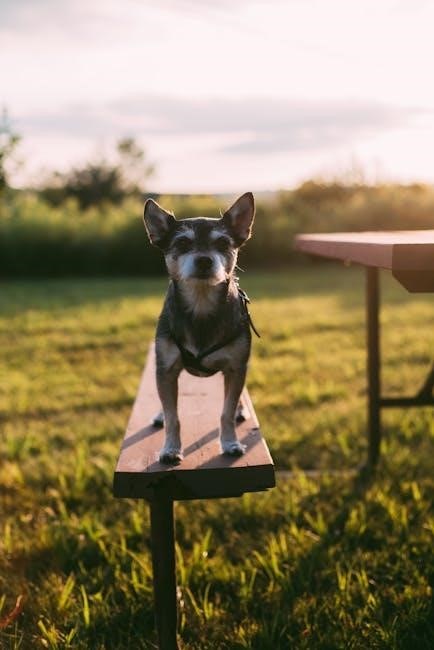
Handling and Communication with a Guide Dog in Harness
Effective communication involves a firm yet gentle grip on the harness handle, clear verbal commands, and trusting the dog’s guidance. While the dog is in harness, it is fully focused on its role, requiring minimal distractions.
4.1 Handling Techniques for Maximum Control
Handling a guide dog in harness requires a combination of confidence, clarity, and trust. Maintain a firm but gentle grip on the harness handle, positioned at a slight angle to ensure optimal control. Use clear, concise verbal commands to guide the dog, ensuring consistent communication. Body positioning is crucial; stand upright and slightly behind the dog to allow it to lead effectively. Avoid pulling or jerking the harness, as this can disrupt the dog’s focus. Instead, rely on subtle movements and verbal cues to navigate obstacles. Trust the dog’s training and instincts, allowing it to make decisions while maintaining gentle guidance. Never grab the harness or leash, as this can confuse the dog and compromise safety. Keep your movements smooth and predictable, enabling the dog to anticipate and respond to your needs seamlessly. By combining these techniques, you can maximize control and foster a strong, trusting partnership with your guide dog.
Responsibilities of a Guide Dog Handler
A guide dog handler has several key responsibilities to ensure the dog can perform its duties effectively. First, they must properly care for the dog, including regular veterinary check-ups, grooming, and maintaining a healthy diet. Handlers are also responsible for ensuring the harness is correctly fitted and in good condition, as it is essential for communication and control. They must adhere to public access etiquette, such as not allowing the dog to be distracted by food or pets while in harness. Handlers should also educate others on how to interact appropriately with a working guide dog, such as not petting or feeding it. Trusting the dog’s training and instincts is crucial, as handlers rely on their guide dogs for safe navigation. Additionally, handlers must stay vigilant in high-traffic or complex environments, ensuring both their safety and the dog’s ability to work effectively. Regular training sessions and ongoing handler education are also essential to maintain the strong partnership between the handler and their guide dog.
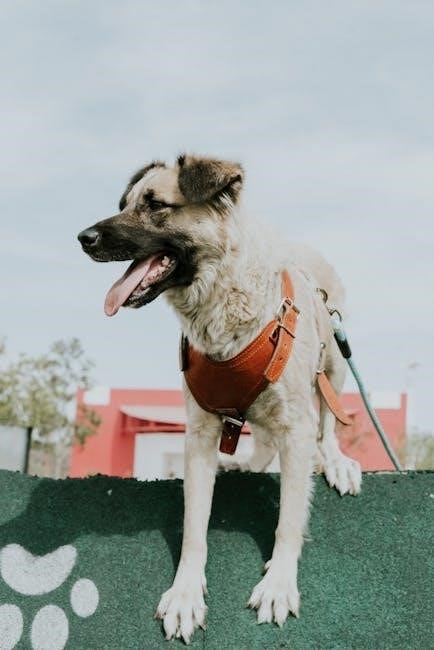
Etiquette and Awareness When Encountering a Guide Dog in Harness
When encountering a guide dog in harness, it is essential to understand proper etiquette to avoid disrupting the dog’s work. Never pet, feed, or make eye contact with the dog, as this can distract it from its responsibilities. Avoid grabbing the harness or leash, as this can confuse the dog and disorient the handler. Speaking to the handler before interacting is courteous, but refrain from engaging the dog in any way. Guide dogs are highly trained to focus solely on their handler when in harness, and interruptions can compromise their ability to navigate safely. It is also important to give the handler and dog ample space, especially in crowded or complex environments. By respecting these guidelines, you help ensure the independence and safety of the handler and their guide dog. Awareness and consideration are key to supporting the important work of guide dogs in harness.
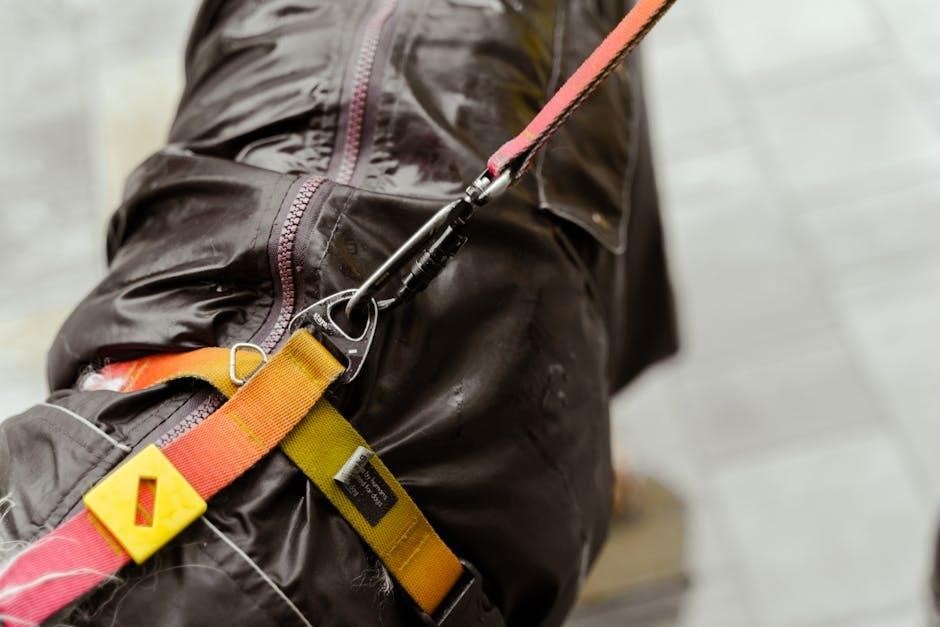
Advanced Topics in Guide Dog Harness Use
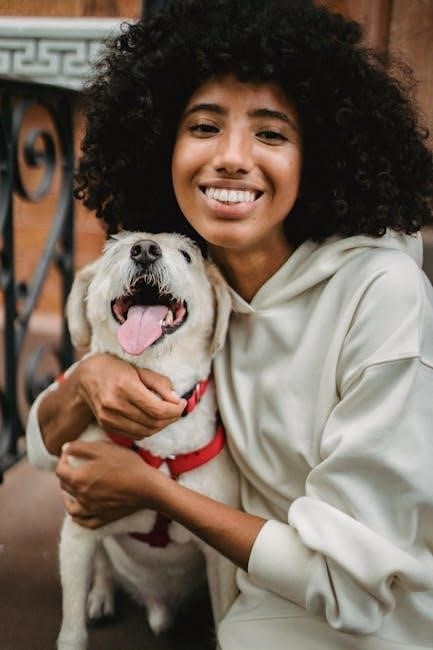
Advanced guide dog harness use involves specialized training and equipment, such as the UniFly harness, designed to enhance handler-dog communication. These systems optimize navigation and independence, ensuring seamless teamwork in complex environments.
7.1 Training Methods for Guide Dogs

Guide dog training is a structured process that equips dogs with the skills to assist visually impaired individuals. The journey begins with puppies learning basic obedience and socialization. Positive reinforcement techniques, such as treats and praise, are used to encourage desired behaviors. As dogs mature, they are introduced to harness training, where they learn to respond to specific commands and navigate obstacles. Advanced training focuses on tasks like stopping at curbs, avoiding overhead hazards, and ignoring distractions. Public access training ensures dogs remain calm and focused in busy environments. Handlers also learn to communicate effectively with their dogs, using consistent commands and body language. The training emphasizes trust and teamwork, ensuring the dog prioritizes its handler’s safety above all else. Regular exercises and refresher sessions maintain the dog’s proficiency. This comprehensive approach ensures guide dogs are well-prepared to provide reliable assistance, enabling their handlers to live independently and confidently.
